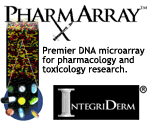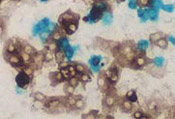Cell division is essential to growth, repair and reproduction in eukaryotic organisms. The process of dividing the genetic material among the daughter cells is integral to both types of cell division. In mitosis, the daughter cells receive the same number of chromosomes as the parent cell. In meiosis, a reductive cell division occurs such that the daughter cells are haploid with respect to the parent cell. The nuclear events occurring in both types of cell division have been described in some detail. Below is a summary of the major events of each stage.
Mitosis
Prophase
Chromatin condenses, each chromosome consists of two sister chromatids, cytoskeleton disassembles, and mitotic spindle begins to form from centriolar organizing centers, nucleoli disappear.
Prometaphase
Nuclear envelope disintegrates into cytoplasmic vesicles, kinetochores form on each centromere and attach to some of the spindle microtubules. During cell division, chromosomes may move by ATP driven microtubule walking protein within the kinetochore or microtubule disassembly may drive movement. Kinetochore contains a protein with high affinity for polymerized tubulin.
Metaphase
Chromosomes are aligned in middle of spindle. At metaphase tubulin subunits are added to the plus end of microtubules at the kinetochore and are removed from the minus end at spindle pole.
Anaphase
Paired kinetochores on each chromosome separate and each chromatid moves toward the spindle pole. At anaphase the kinetochore moves because subunits are removed from the plus ends of the microtubules.
Telophase
Kinetochore microtubules disappear, new nuclear envelope forms around each group of daughter chromosomes, chromatin expands and nucleoli reappear.
Cytokinesis
Cleavage furrow forms around the equatorial middle of the cell and a cytoplasmic contractile ring contracts until remains of mitotic spindle are encountered. The spindle finally breaks and the membranes fuse leaving two separated daughter cells.
Meiosis
In meiosis, two successive cell divisions after one round of DNA replication give rise to four haploid cells from a single diploid cell. This process is necessary to the formation of gametes so that the resulting zygote is a product of the fusion of haploid maternal and paternal genes. With the exception of the sex chromosomes, a diploid nucleus contains two similar versions of each chromosome. During DNA replication the two copies of the fully replicated chromosome remain closely associated and are called sister chromatids. A haploid cell resulting from meiosis must contain only one member of each homologous pair of chromosomes and therefore only half of the original number of chromosomes. To accomplish this, the homologues must pair up before they line up on the meiotic spindle. This bivalent contains four chromatids and each daughter cell receives two copies of one of the two homologues when the meiotic cell divides for the first time. The formation of haploid cells can now proceed via a second cell division, in which chromosomes align on a second spindle and the sister chromatids separate in division II of meiosis as in mitosis.
No two offspring of the same parents are genetically the same unless they are identical twins. This is because genetic reassortment that occurs during meiosis. Random genetic shuffling of maternal and paternal homologues to daughter haploid cells in meiosis allows for some reassortment. Another type of reassortment, chromosomal crossing over, occurs when parts of homologous chromosomes are exchanged. On average two or three crossover events occur on each pair of human chromosomes during prophase of the first meiotic division.





